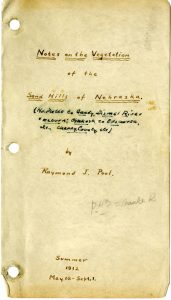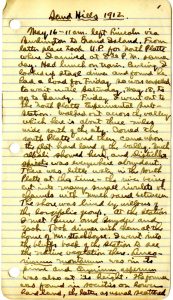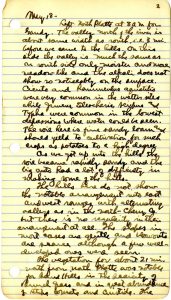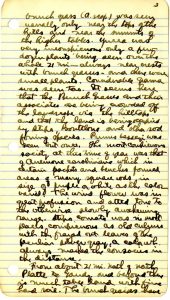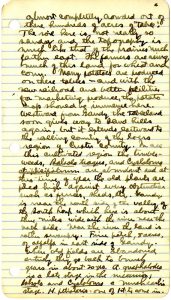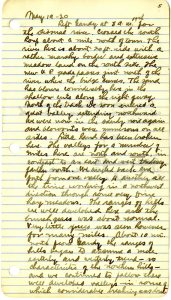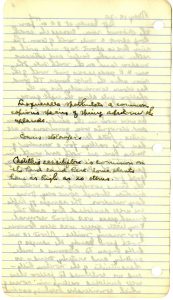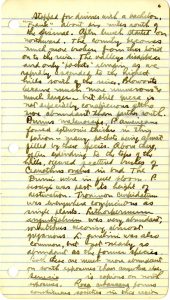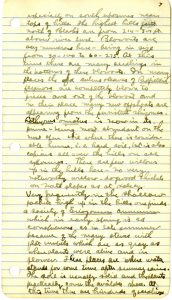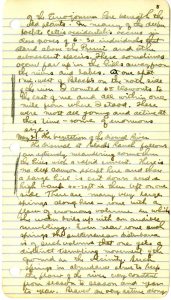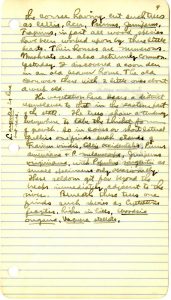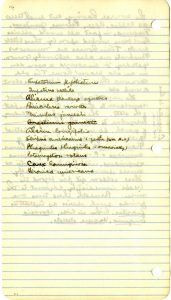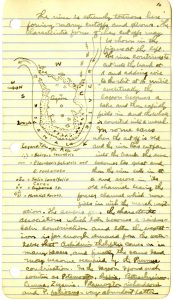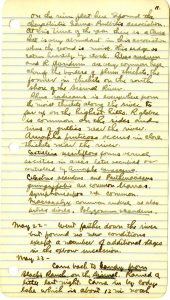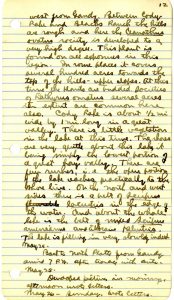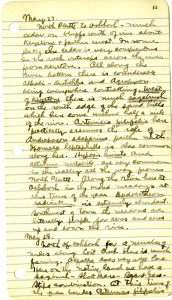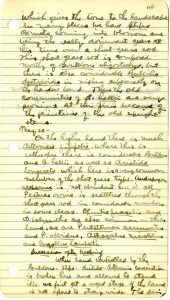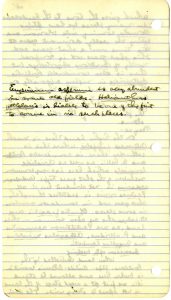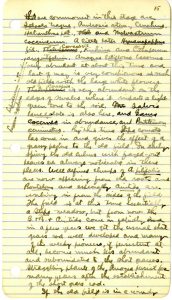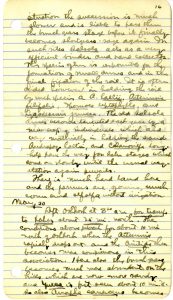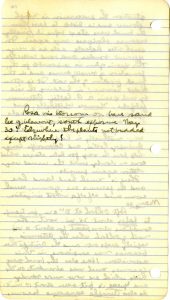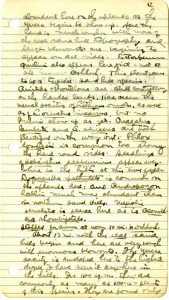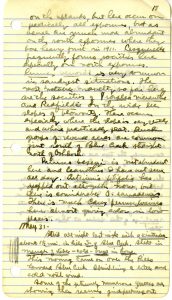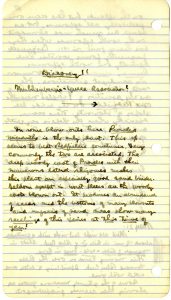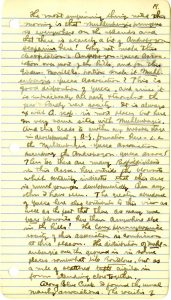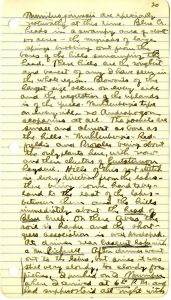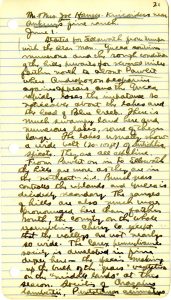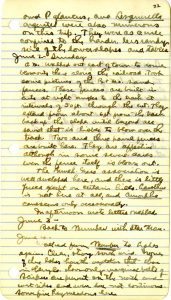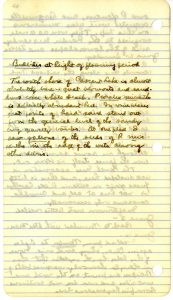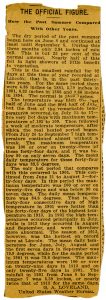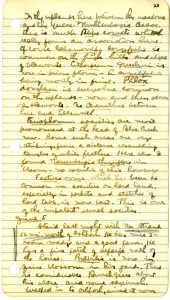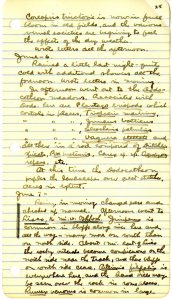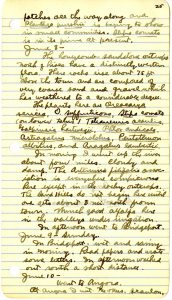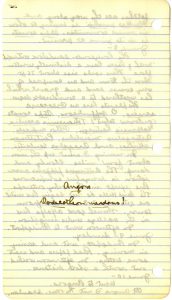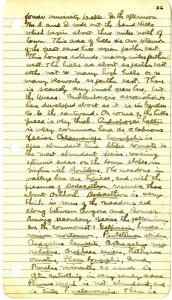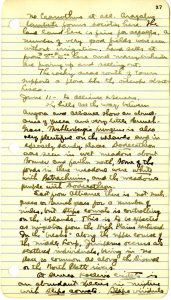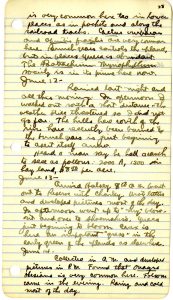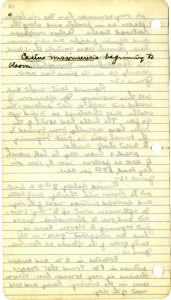Great Nebraska
Naturalists and ScientistsRaymond J. Pool, Notes, 1912, Part 1
titlepage
cover
Notes on the Vegetation
of the
Sand Hills of Nebraska
(No. Platte to Gandy, Dismal River
& Return; Oshkosh to Ellsworth,
etc., Cherry County, etc.)
by
Raymond J. Pool
Summer
1912
>May 16 – Sept. 1
1
Sand Hills 1912
May 16 & 11 am. left Lincoln via Burlington to Grand Island. From latter place took U.P. fro North Platte where I arrived at 8:30 P.M. same day. Had lunch on train. Evening I looked up stage
driver and found he had a load for Friday so was compelled to wait until Saturday,
May 18, to go to Gandy. Friday, I went out to the North Platte Experimental Substation. Walked out across the valley which here is about three miles wide south of the city.
Crossed the North Platte and then came upon the flat hand land of the valley. Much alkali showed here, and
Distichlis spicata was everywhere abundant. There was little water in the South Platte at this time — the river being cut into many small in rivulets or channels with much
sand between. The shore was lined by willows of the longifolia group. At the station I met Burr and Snyder and Zook. Took dinner with them at the
home of Mr. Stackhouse. I went into the bluffs back of the station to see the native
vegetation there. Leucocrinum montanum was in its prime and Erysimum asperum was also at its height. The former was found in societies on lower hard land, the
latter as usual scattered.
2
May 18 —
Left North Platte at 8 am for Gandy. The valley north of the river is about some width as south, i.e. 3 mi. before we
came to the hills. On this side the valley is much the same as on the south side only
moister and more meadow like and the alkali does not show so noticeably on the surface.
Cicuta and Ranunculus aquatilis were very common in the wetter sites while Juncus, Eleocharis, Scirpus and Typha were common in the lowest depressions where water could be seen. The soil here is
fine sandy loam and should yield to cultivation for such crops as potatoes to a high
degree.
As we got up into the hills the soil became rapidly sandy and the big auto had a lot
of difficulty in making some of the hills.
The hills here do not show the notable arrangement into east and west ranges with
alternating valleys as in the north — Cherry Co. but there is not reqularity in their arrangement at all. The slope in most cases
are gentle and blowouts are scarce although a few well developed ones were seen.
The vegetation for about 21 mi. north from North Platte was notable for Sand Hills in the scarcity of Bunch Grass and in great abundance of Stipa comata and Aristida. The
3
bunch grass (A. scop.) was seen usually only near the tops of the hills and near the summits of the higher
tables. Yucca was very inconspicuous only a few dozen plants being seen over the whole
21 mi. always near crests with bunch grasses — and there were small plants. Considerable
grasses was seen too. It seems here that the Bunch Grasses and their associates are
being crowded off the landscape via the hilltops and that the land is being occupied
by Stipa, Bouteloua, and other sod forming species. Prunis besseyi was seen but once. The most conspicuous society at this time of year was that of
Anemone caroliniana which in certain pockets and bunches formed areas of many square sods in size of
purple or white as the color varied. The wind flower was in great profusion and added
tone to the otherwise slowly awakening range. Stipa comata was in more places conspicuous as old culsuss with the frayed out leaves of the peculiar silver gray, a color wh. always marked
the consocies in the distance.
From about 21 north of North Platte to Gandy, and beyond there is much table land with fine hard soil. The bunch grasses have
4
almost completely crowded out of these hundreds of acres of “Table.” The soil here
is not nearly so sandy and the topography is much like that of the prairies much farther
east. The farmers are giving much of the land for wheat and corn. Many potatoes are
produced on there tables – and with the new railroad and better facilities for marketing
produce, the potato crop should be immense here. Westward from Gandy the tableland soon gives way to sand hills again, but it extends eastward to the rolling country of the loess region of Custer County. In all this cultivated region the tumbleweeds, Salsola tragus, Cycloloma atriplicifoliumare abundant and at this time of year the old plants are piled high against every
obstruction such as fences, sheds, etc. Gandy is near the south side of the valley of the South Loup which here is about three miles wide with the river near the north side. Near the
river the land is rather swampy. Fine patch, 8 acres of alfalfa in east side of Gandy. When old fields are abandoned entirely they go back to bunch grass in about 20 yrs.
A.gnaphalodes is a late stage in the meaning; Salsola and Cycloloma a much early stage. H. petiolaris = one of 1st to come in.
5
May 19 & 20
Left Gandy at 8 am 19th for the Dismal River. Crossed the South Loup about a mile north of town. The river here is about 20 ft. wide with a rather marshy
border and extensive meadow land on the south side. The new U.P. grade has us just
north of the river where the bridge crosses. The sand has blown considerably here
in the shallow cuts along the right of way. North of the track we soon entered a great
valley extending northward. We were now in the sandy soil again and blowouts were
numerous on all sides. Little land has been broken here. The valleys for a number
of miles here are north and south, in contrast to an east and west [tendency?] farther north. We angled back and forth from one valley to another all the time workig
in a northwest direction through some very fine hay meadows. The ranges of hills are
well are well developed here and the bunch grass was about normal. Very little yucca was seeen however for many miles. About 10 mi. north from Gandy the ranges of hills began to assume a more earthly and westerly trend — no characteristic
of the northern hills — and we continued to follow there well developed valleys in
some of which considerable breaking was done.
Lesquerella spatulata a common copious species of spring aspect over the uplands.
Cornus stolonifera
Castilleja sessiliflora is common on the hard land here. Some plants have as high as 20 stems.
6
Stopped for dinner with a bachelor, “Frank” about six miles south of the Dismal. After lunch started on northward. The country becomes much more broken from this
point on to the river. The valleys disappear and only “pockets” remain as we rapidly
ascended to the highest hills south of the river. Blowouts became much more numerous
and much larger, but still yucca is not especially conspicuous altho more abundant than farther south. Prunus melanocarpa, P. Americana formed extensive thicks in this portion — many pockets being almost filled by these
species. Abover there often extending to the tops of the hills, occured scattered
bushes of Ceanothus Ovatus in bud. The Prunus were in full bloom. P. Besseyi was past its height of aestivation. Troximon cuspidatum was everywhere conspicuous as single plants. Lithospermum angustifolvim was very abundant, sometimes becoming almost gregarious. L. gracilis was also common, but not nearly so abundant as the former species. Both these are
much more abundant on south exposures than anywhere else. Senecio is copious on north exposures. Rosa arkansana forms conspicuous societies in the this region.
8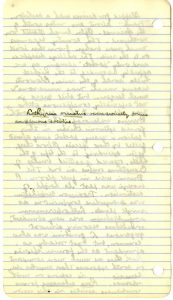
Lathyrus omatus occasionally conspicuous societies.
7
especially on south exposures near tops of hills. The highest hills just north of
Bead‘s are from 214 — 300 ft. above river land. Blowouts are very numerous here — being
in size from 30 — 100 to 60 — 275. At this time there are many seedlings in the bottoms
of there blowouts. In many places the old culins & leaves of Redfieldia flexuousa are completely blown to pieces and out of the blowout and in their place many new
offshoots are appearing from the persistent rhizomes. Lathyrus omatus is now in its prime — being most abundant on the most open soil where there is considerable
hummus, i.e. hard soil, but is also copious all over the hills on all exposures. there
are few willows up in the hills here — no very noteworthy willow — dogwood thickets
on north slopes as at Halsey.
Very frequently in the shallow pockets high up in the hills one finds a society of
Eriogonum annuum which in early spring is as conspicuous as in late summer became of the many stems
with flat umbels which are as gray as when plants were alive and in flower. The places
are where water stands for some time after summer rains. The soil is usually solid
and the plants practically cover the available space. At this time there are hundreds
of seedlings
8
of the Eriogonum here beneath the old plants. In many of the deeper pockets Celtis occidentalis occus in close groves of 6 — 30 individuals that stand abone the Pruni and the arborescent species. These sometimes occurs far up in the hills away from
rivers and lakes. At one spot 1 mi. west of Black‘s on the north side of the river I counted 68 blowouts to the east of me and all
within one mile from where I stood. These were most all and active at this time —
none of enormous size.
May 21
The vegetation of the Dismal River
The Dismal at Black’s Ranch follows an extremely meandering course thru the hills with a rapid current. There
is no deep canyon except here and there a large hill is cut down and a high bank 60
— 70 ft is then left on one side. There are many very large springs along here — some
with a flow of enormous volume in which the water soils up with an audible rumbling.
Even near some such springs the subteranean disturbance is of such volume that one
gets a distinct trembling movement of the ground in the vicinity. Such springs in
abundance strive to keep the flow fo the river very constant from season to season
and year to year. However beaver are very active along
9
the course having cut such trees as Celtis, Acer, Prunus, Juniperus, Fraximus, in fact all wood species have been worked upon by the little beasts. Their houses
are numerous. Muskrats are also extremely common. Yesterday I discovered a coon den
in an old beaver home. The old coon was there with 2 little ones about a week old.
The vegetation here is as a distinct resemblance to that in the eastern part of the
state. The trees show a tendency everywhere to take the thicket form of growth. So
in coves or short lateral gullies one finds such stands of Fraixum vividis, Celtis occidentalis, Prunus americana & P. melanocarpa, Juniperus virginians, with Populus sargentii as small specimens only occasionally. There seldom get far beyon the breaks immediately
adjacent to the river. Beneath these trees one finds such species as Cystopteris fragilis, higher in hills, Woodsia oregana, Vaquera stellata
- Eupatorium perffliatum
- Imaptiens pallida
- Alisma plantago-aquatica
- Panicularia nervata
- Mimulus jamesii
Minimulus jamesii- Alsine longifolia
- Scirpus americanus (farther from H2O)
- Phragmites phragmites
- Potamogeton natans
- Carex limosa
- Veronica americana
10
The river is extremely tortuous here flowing many cutoffs and oxbows. The characteristics
form of where cut offs may be shown in the figure at the left. The river continues
to cut into the bank at A and adding soil to the slit at B until eventually the lagoon
becomes a lake and then rapidly fills in and the whole is converted into a marsh.
In some cases when the cut off is old and the view has cut far into the bank the curve
becomes too great and then the view cuts in at A and across in its old channel leaving
the former channel which now fills in with the marsh vegetation. The scirpus form
the characteristic associations which later becomes a ruderal salin combination and
later the vegetation is far enough removed from the water-table that ruderal comes
in many places, adn finally the same land may become occupied by the Prunus combination . In the lagoon I found much societies as Potamogeton, Ruppia, Batrachium, Lemna, Zizania, Potamogeton richardsonii , and P. foliosus — very abundant latter.
11
on the river flat here I found the characteristic Nama — Bulbilis association. At this time of the year there is a Carex that is very abundant in this association where the ground is moist. This sedge is
eaten heartily by stork. Ribes aureum and R. floridum are very common here along the borders of plum thickets. The former in thickets on
the south shore of the Dismal River.
Rhus radicans is everywhere from the moist thickets along the river to far up on the highest hills.
R. glabra is common on the sides and rims of gullies near the river. Amorpha fruticosa occurs in close thickets near the river. Castieleja sessiflora forms vernal societies in areas later occupied or controlled by Amorpha canescens. Celastrus scandens and Parthenocissus quinquefolia are common lianas. Symphoricarpos esp. common. Macracalyx common ruderal as also as Urtica dioica, Polygonum scandens
May 22—
Went farther down the river but found no new conditions except a number of additional
stages in the oxbow succession.
May 23—
Came back to Gandy from Black’s Ranch on the Dismal. Rained a little last night. Came in by Cody lake which is about 12 mi. north.
16
12
west from Gandy. Between Cody Lake and Black’s Ranch the hills are rough and here the Ceanothus ovatus society is developed to a very high degree. This plant is found on all exposures
in this region. In some places it covers several hundred acres towards the top of
the hills — upper slopes. At this time the plants are budded. Societies of Lathyrus omatus several acres in extent are common here also. Cody Lake is about 1/2 mile wide by 1 mi. long in a great valley. There is little vegetation
in the lake at this time. The shores are very gentle about this lake it being simply
the lowest portion of a great hay valley. There are few numbers, i.e. the open portion
of the lake reaches practically to the shore line. On the north and west sides there
is a belt of Scirpus lacutris in the edge of the water. And about the whole lake is the belt of mixed scirpus americanus and Eleocharis palustris. The lake is filling in very slowly indeed.
May 24—
Back to North Platte from Gandy. Arrived 7 p.m. after trouble with auto.
May 25—
Developed pictures in morning afternoon wrote letters.
May 26—
Sunday. Wrote letters.
13
May 27—
North Platte to Oshkosh — much cedar on bluffs south of river about Keystone & farther west. In some places, the cedar is very conspicuous in the rock outcrops
across the river from Keystone. All along the river bottom there is considerable Alkali
— Distichlis and Agropyron being everywhere controlling. West of Keystone there is much sagebrush on the south edge of the sand hills which here come with half a mile of the river. Artemisia filifolia here practically assumes the role of Andropogon scoparius farther north. Ipomoea leptaphylla is also common along here. Hypoxis hirsuta and Allium mutabile are very common in the valley all the way from North Platte. Along the river here at Oshkosh in the broad meadows at this time of the year Dodecatheon radicatum is extremely abundant. Southwest of town the meadows are literally simple for acres and acres
up and down the river.
May 28
North of Oshkosh for a number of miles along Lost Creek there is much farming. Alfalfa does very well here. Here on the native land we have
a sagebush — short grass — beard grass — Stipa combination. At this time of the year besides Artemisia filifolia
14
which gives the tone to the landscape in many places we have Stipa comata coming into blossom and being the really dominant grass at this time over a short-grass
sod. This short-grass sod is composed mostly of Boutelona oligostachya, but there is also considerable Bulbilis dactyloides in mixture especially on the harder land. Then the old communities of A. Hallii are very persistence of the old upright stems.
May 29—
On the higher land there is much Artemisia filifolia. Where this is rather open there is considerable Bouteloua and A. hallii as well as Aristida longisets which here is a very common member of the short grass type. Andropogon seoparius is not abundant here at all. Festuca ovina is scattered through the short grass sod in considerable number in some places. Opuntia fragilis and O. Polyacantha are also common on this land, as are Penstemon acuminatus, and P. albidus, Astragalus microlobus and Aragallus lambertii.
Where land controlled by the Bouteloua — Stipa — Aristida — Artemsia coveristion is broken hear and allowed to stand idle we first get a weed stage if
the land is not exposed to strong winds. The species
Erysimum asperum is very abundant in some old fields. Helianthus petiolaris is liable to be one of the first to come in in such places.
15
that are common in this stage are Salsola tragus, Ambrosia artem., Cenchrus, Helianthus pet., and Malvastrum coccineum. A little later Hymenopappus fil., Coreopsis, Kuhnia, Lithospermum angustifolium. Anogra latiflorus becomes very abundant at about this time and last of may is very conspicuous in such
old fields with the large large white flowers. Coreopsis is very abundant on the edges of swales where it imparts a light green tone to the
soil. Salvia lanceolata is also here, and Gama Coccinea in abundance, and Pentstemon acuminatus. By this time Stipa Comata has come in and gives the effect of a grazing pasture to the old field. In early
spring the old Cubus with frayed-out leaves are always noticeable in there places. Well defined chunks
of A. filifolia are now appearing from old roots and Bouteloua and especially Aristida are working in from the sides of the field. The field is at this time essentialy
a Stipa meadow, but from now the B.B. & Aristida come in rapidly and in a few years we get the usual short grass sod well developed
and many of the weedy pioneers, if persistent at all, become much less abundant and
subordinate to the short grasses. Stragglling plants of the Anogra persist for many year after the establishment of the short grass sod.
If the old field is in a windy
16
situation the succession is much slower and is liable to pass them the bunch grass
stage before it finally becomes shortgrass — sage again. In such sites Salsola acts as a very efficient binder and sand collector. This species often is responsible
for the formation of swale dunes and in the final fixation of the soil. It is often
aided however in holding the soil by such species as A. Hallii, Artemisia filifolia,Ipomoea leptophylla, and Lygodesmia juncea. The old Salsola become tenanted each year by a new crop of individuals which aid very very materially
in holding the sand. Andropogon Hallii, and Calamovilfa long. help pave the way for later stages which come on slowly until the usual vegetation
again prevails.
There is much hard land here and the farmers are growing much corn and alfalfa without
irrigation.
May 30
Left Oshkosh at 8:20 am for train to Lakes about 25 mi. north. The conditions above prevail for about 10 mi. north of Oshkosh when the Artemisia rapidly drops out and the Aristida then becomes, more conspicuous in this association. Here also the bunch grass becomes
much more abundant on the hills which are now more sandy and Yucca is first seen about 10 mi. N. So also Amorpha canescens becomes
Rosa in blossom on base sand of blowout, south exposure May 30! Elswhere the plants not budded except
slightly!
17
abundant here on the uplands as the yucca begins to show up. Here the land is much
rougher with more of the real sand hill topography and large blowouts are beginning
to appear on all sides. Lithospermum gmelini also appears here first — not at all nearer Oshkosh. This plants seems to be a typical sand hillspecies. Aristida & Bouteloua are still controlling the harder lands. Here occur the usual societies of Lathyrus omatus, as were as L.ormatusa vicarus but no Prunus show up as yet. Aragalus lambertii and A. sericeus are both plentiful on the way out.Phlox douglasii is common too along the hard road sides. Seedlings of Helianthus scaberrimus appear here where in the hills at this time of year. [?]Lesquerella spatulata is common on the uplands here; and Andropon hallii much more abundant than in northern sand hills. Mexiolia senulota is scarce here as is Oenothera rhombipetala.
Stopped for dinner at noon 10 mi. N.Oshkosh.
About 12 mi. north the real sand hills begin and here are very rough with enormous blowouts. The Yucca society is developed
here to the highest degree I have seen it anywhere in the hills. In 100 sq. m. there
are commonly as many as 100-150 plants of this species. They are formed only
Phaca longifolia in bloom May 30.
Yucca glauca racemes appear ”
Prunus besseyi petals all off.
18
on the uplands, but here occur on practically all exposures, but as usual are much
more abundant on the south exposures where they bore heavy fruit in 1911. Lesquerella frequently forms societies here especially on north exposures.
Rumex venosus is very common in sandiest situations. The most notable novelty so far here are the
societies of Rosalea mierantha and Redfieldia on the wide lee slopes of blowouts. There occur expecially where the slope is very
gentle and where practically feat. such groups of several acres are common just of Blue Creek straight north of Oshkosh.
Prunus besseyi is not abundant here and Ceanothus I have not seen all day. Artemisia filifolia has dropped out altogether now, but there is considerable A.canadensis There is much Carex pensylvanica here almost giving color in low places.
May 31
Staid all night last night with a homesteader about 1 1/2 mi. in hills S. of Blue Creek. Slept in manger of stable — cold — bugs in home. This morning came on over the hill
toward Blue Creek. Sprinkling a little and cold north wind.
Some of the extremely numerous Yuccas are showing the racemes just peeking out.
Discovery!!
Muhlenbergia — Yucca Association!
In some blow-outs here Psoralea micrantha is the only plant. This sp. spatulata seems to beat Redfieldis sometimes. Very commonly the two are associated. The deep woody root of of Psoralea with their numerous lateral rhizomes makes this plant an especially good sand binder.
Seldom except in worst places are the woody roots blown out. It produces an abundance
of seeds and the bottoms of many blowouts and surfaces of sand area show many seedlings of this species at this time of year!
19
The most surprising thing noted this morning is that Muhlenbergia pungens is everywhere on the uplands and that there is scarcely a bit of Andropogon scoparius here! Why not make this classification = Andropogon — Yucca Association over most of the hills, and for Garden — Morrill Co. portion make it Muhlenbergia — Yucca association? This is good distribution of Yucca, and since it is in practically all
parts througout the year = hardly mere society. It is always in the A.scap. in most places but here in very same sites with Muhlenbergia. And this leads to another my probable stage in developement of R-S. formation here
— i.e. the Muhlenbergia — Yucca association suceeding the Andropogon — Yucca assoc.! Then too there are many Redfieldia plants in this assoc. here outside the blowouts which certainly indicates that this area is much younger
developmentally than any other I have seen. The greater abundance of Yucca here also contributes to this view as well as the fact that there are many more bare blowouts here than anywhere else in the hills! The Carex pensylvanica society of this association is conspicuous at this season. The distribution of Muhlenbergia over the ground is in some places somewhat like Bouteloua, but as a rule a scattered tufts similar in form standing close together.
Along Blue Creek I found the usual marshy associations. The societies of
Azolla is very abundant at head of Blue Creek — in places giving a distinct maroon color to the surface of its pools!
20
Mimulus jamesii are especially noteworhty at this time. Blue Cr. heads in a swampy area of about 100 acres — the myriads of large springs bubbling
out from the vanes of the hills surrounding the head. There hills are the roughest
and barest of any I have seen in the whole region. Blowouts of the largest size seem
on every side and the vegetation of the uplands is of the Yucca — Muhlenbergia type on every side, no Andropogon scoparius at all. The pockets are small and almost as bare as the hills — Muhlenbergia — Redfieldia and Psoralea being about the only plants here, with now and then clusters of Penstemonhaydenii. Hills of this sort stretch in every direction from the lakes — there being some
hard table land to the east of the lakes — between them and the hills immediately
about the head of Blue Creek. On these tables the soil is harder and the shortgrass association is well developed.
Ate dinner near Crescent Lake with a M. Pickerell. After dinner went out to the lakes, but since it was still very cloudy, too cloudy
for picking, I pushed on to Mumper where I arrived at 6:20 P.M. and had supper & staid all night with
21
Mr. & Mrs. Joe Hanser — Kriscaiders near Ankeny’s fine ranch.
June 1
Started for Ellsworth from Mumper with the Stan Man. Yucca continues numerous and the rough condition of the hills prevails for several miles
farther north to about Pawlet where Andropogon scoparius again appears and the Yucca rapidly loses the impatance so noticeable about the lakes and the head of Blue Creek. There is much swampy land here and numerous lakes, some of them large. The lakes
usually show a wide belt (20-100 ft) of Distichlis spicata. They are all alkaline. From Pawlet on in to Ellsworth the hills are more as they are in the northeast — i.e. Bunch-grass controlls the uplands and Yucca is decidedly secondary. The ranges of hills are also much more pronounced here than
farther south, the county on the whole resembling Cherry Co. except that the valleys are not nearly so wide. The Carex pensylvanica society is developed in fine degree here — the species making up the bulk of the
“grass” vegetation on the “middle lands” at this season. Society of Aragalus lambertii, Penstemon accuminatus
22
and P. glaucus, and Lesquerella argentea were also numerous on this trip. They were as a rule confined to the harder, less
sandy soil of the lower slopes and tables.
June 2 – Sunday
A.M. walked out east of town to some blowouts there along the railroad. Took some
pictures of the B. & M.’s sand fences. These fences are built in cuts at right angles
to the track at intervals of 50 ft. through the cut. they extend from about 6 ft.
from the track back up the slope until beyond all sand that is liable to blower over
the track. Two and three normal fences are built here. They are affective although
in some severe cases even the fence itself is blown out.
The Bunch Grass asscociation is well developed here, and there is little Yucca except on certain hills. Causthus is not here at all, and Amorpha canescens only occasionally.
In afternoon wrote letters napped
June 3—
Back to Mumper with Stan Man.
June 4—
Walked from Mumper to Lakes again. Clear, strong south wind. None of the lakes have the vegetation that
those in Cherry Co. show only marginal belts of Scirpus are present on the north and west sides and even here not continuous. Some fine hay
meadows here.
Bulbilis at height of flowering period.
The south shore of Crescent Lake is almos absolutely have — great blowouts and sand dunes cover whole beach. Psoralea micrantha is especially abundant here. In some places great points of hard sand stand out from
the general leveal of the sandy and gravelly banks. At one place I saw gallons of
the seeds of P. micrantha in the edge of the water among other debris.
The Official Figure
How the Past Summer Compared With Other Years.
The dry period of the past summer began here on June 8 and conitnued at least until
September 8. During this three months only 2.84 inches of rain fell. This is but 25
per cent of the normal amount. Nearly half of this fell in light showers of little
benefit to vegetation.
This is the smallest rainfall for 92 days at this time of year recorded at Lincoln;
that is, in the past thirty two years. Form the same period there were 4.86 inches
in 1881, 5.39 in 1901, 6.33 inches in 1886 and 9.86 inches in 1894. the normal is
11.33 inches. The temperature was high this last half of June and the first half of
July , but the remarkable temperatures occured on July 13 to 17 — five very hot days
with maximum temperatures of 102 to 109. then followed a week of moderate tempereature,
after which the real heated period began. From July 26 to September 7 high temperature
continued alomst without a break. The maximum temperature was 100 or over on twenty
three of those forty-four days was ,and it was below 90 on only seven days. The mean
daily temperature for these forty-four days was 83.5 degrees.
The only hot period that compares with this occurred in 1901. This continued from
June 21 to August 3 — for forty-four days. In this period the maximum temperature
was 100 or over on twenty-five days and was below 90 on seven days. The daily mean
temperature was 84.6 degrees. That is, the forty-four consecutive days of high temperature
in 1901 were hotter than the forty-four days of the highest temperature in 1913. In
1901 the high temperatures occured in August and September, and were therefore more
abnormal. The season of 1913, however, was the hottest on record here at Lincoln. The mean daily tempereature for June, July, Aguest adn the first seven days in September
was 79.9 degrees, while for the same period in 1901 it was 78.6 degrees. The maximum
temperatures were 100 or over on twenty-nine days in 1913 and on only twenty-five
days in 1901. the rainfall in 1901 form June 8 to September 7 was 5.59 inches, or
nearly twice that of 1913 for the same days.
G.A. Loveland,
United States Weather Bureau.
23
On the uplands here between the meadows and the Yucca & Muhlenbergia assoc. there is much Stipa comata which really forms an association here. Of course, Calamovilfa longifolia is common on the high hills and edges of blowouts. Lithosperm gmelini ins now in prime flower — L. angustifolium being mostly in first. Phlox douglasii is everywhere common on the uplands — now and then occur in blowouts. No Ceanothus between hear and Ellsworth.
Eriophorum societies are most pronounced at the head of Blue Creek now. Some such areas are very striking, from a distance resembling tangles of white
feathers. Here also I found Naumburgia thyrsiflora in bloom — no society of this however.
Festuca ovina which has been so common in societies of hard land, is now past. This is one of the
imporant vernal societies.
June 5
Staid last night with Mr. Strand 12 mi. north of Oshkosh. He has nice 3 — room soddy and a good farm. He has a fine patch of Alfalfa north
of the house. Bulbilis is now in fine blossom in his yard. There is considerable Bunch Grass about his place
and some sagebrush. Walked in to Oshkosh, arrived at noon.
24
Coreopsis tinctoria is now in full bloom in old fields, and the various vernal societies are beginning
to feel the effects of the dry weather.
June —6
Rained a little last night — quite cold with additional showers all the forenoon.
Wrote letters in morning.
In afternoon went out to the Dodocatheon meadows. Associates with Dods. here Plantago eriopoda which controls in places,
- Triglochin maritima,
- ” ” “, Juncus balticus,
- ” ” “, Eleocharis palustris,
- ” ” “, Vaquera stellata and
- ” ” ” Equisetum laevigatum
, all there in a rod composed of Distichlis spicata, Poa malimsis, Carex sp. sp. Agropyron repens, etc.
At this time the Dodecatheon pimples the landscape over great sketches, acres in extent.
June 7—
Rowing in morning changed piers and checked up manual. Afternoon went to Lisco, 16 mi. Oshkosh. Junipers is common in bluffs along river here and all the way — many more on the south than
on north side. About 1 mi. east of Lisco the rocky outcrops become conspicuous on the North side near the track, and there
bluffs on south side cease. Artemisia filifolia is everywhere here, and the Sand Hills may be seen over the rock in some places. Rumex venosus is common in large
25
patches all the way along and Platago purshii is begining to show in small communities. Stipa Comata is in its prime at present.
June 8—
The honeycomb—sandstone outcrops north of Lisco have a distinctly western flora. There rocks rise about 75 ft. above the town and
are composed of very coarse sand and gravel which has weathered to a considerable
degree.
The plants here are Oreocarya sevicea, O. suffucticosa, Stipa comata (on lower talus), Tetraneuris acaulis, Galpinaria hartwegii, Phlox andicola, Astragalus Micrololus, Penstemon albidus, and Aragalus lambertii.
In moving I went up the river about four miles. Cloudy and damp. The Artemisia filifolia association is everywhere conspicuous here except in the rocky outcrops. The Sand Hills do not begin here until one get about 8 mi. north from town. Much good alfalfa here
in the valleys under irrigation.
In afternoon went to Bridgeport.
June 9— Sunday
In Bridgeport — wet and rainy in morning. Read papers and wrote some letters. In afternoon walked
out south a short distance.
June 10—
Went to Angora
At Angora I visit Mr. & Mrs. Scanlon
Angora
Dodecatheon meadows!
26
former university people. In the afternoon Mr. S and I rode out the Sand Hills which begin about three miles north of town. This area of hills as an exterior of
the Sand Hill region farther east. The toungue extends many miles farther west. The hills are about
as farther east altho mot so many high hills or so many blowouts as farther east.
There is scarcely any bunch grass here, but the Yucca — Muhlenbergia association is here developed about as it is in Garden Co. to the eastwards. On some of the hills Yucca is very thick. Andropogon hallii is very common here as a copious species. Calamovilfa longifolia is also abundant here. Stipa comata is the most abundant species, covering extensive ares on the lower slopes in mixture
with Bouteloua. The meadows in valleys here are typical, and, with the presence of
Dodecatheon, resemble those about Oshkosh. Dodecatheon is very thick in some of the meadows all along betweeen Angora and Bomner. Among scecordary species the following are the commonest:
- Galpinsia,
- Lineorium montanum,
- Penstemon albidus,
- Anagalus lambertii,
- Astragalus microlobus,
- Orophaca sericea,
- Lathyrus omatus,
- Phaca longifolia,
- and Psoralea micrantha,
as much is often controlling in very sandy areas. Prunus besseyi is not abundant and is little P. melanocarpa. There is
27
No Ceanothus at all. Aragalus lambertii forms societies here. The hard land here is fine for alfalfa, a number of very good
fields were seen without irrigation. Land sells a from $8.00 — $15.00 here and many
kind consider one proving up and selling out.
The rocky areas south of town supports a flora like outcrops about Lisco.
June 11 — to Alliance & Seneca
The hills all the way between Anogra and Alliance show an abundance. Once of Yucca and very little Bunch Grass. Muhlenbergia pungens is also very plentiful on the uplands and it espcecially sandy places. Dodecatheon was seen in wet meadows about Bomner and farther north, some of the ponds in there meadows were white with Batrachium, and the meadows purple with Dodecatheon.
East from Alliance there is not much Yucca on Bunch Grass for a number of of miles, but Stipa Comata is controlling on the uplands. this is to be expected as migration from the High Plains eastward. In the “breaks” along the upper course of the Middle Loup. Juniperus occurs as scattered individuals, being in no place so common as along the Dismal or North Platte river.
At Seneca Koleria critata is an abundant species in mixture until Stipa Comata. Stipa vinidulo
28
is very common here too in lower places as in pockets and along the railroad tracks.
Cactus vurbasas and Opuntia fragilis are very common here. Bunch Grass controls the upland, but in places Yucca is abundant.
The Batrachium — Myriophyllum society is in its prime here now.
June 12—
Rained last night and all this morning. In afternoon I walked out south a short distance
— the weather threatened so I did not go far. The hills here south of the river have
recently been farmed & the bunch grass is just beginning to asert itself anew.
Heard a man say he had a ranch to sell as follows: 2000 A, 1500 in hay land, $8.00
per acre.
June 13
Arrived Halsey 8:18 a.m. went out to Reserve with Charley. Wrote letters and developed pictures most of the day. In afternoon went up to “my”
blowout and over to Shoemaker’s. Yucca just beginning to bloom. Carex is here an important “grass” in the early green of the uplands as elsewhere.
June 14—
Collected in A.M. and developed pictures in P.M. Found that Onagra oaksiana is very common here. Folsom came in the evening. Rainy and cold most of the day.
Cactus missouriensis beginning to bloom.
